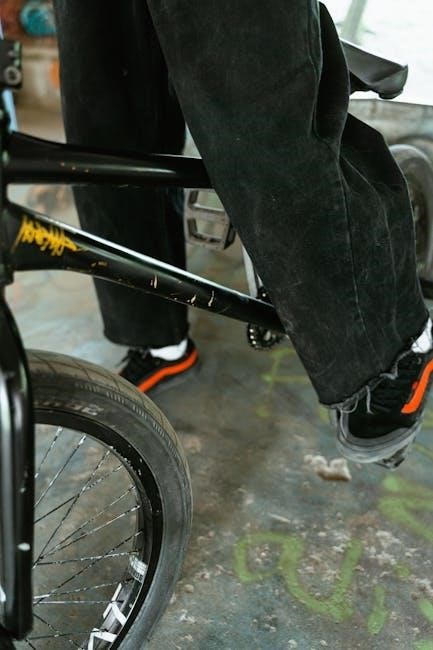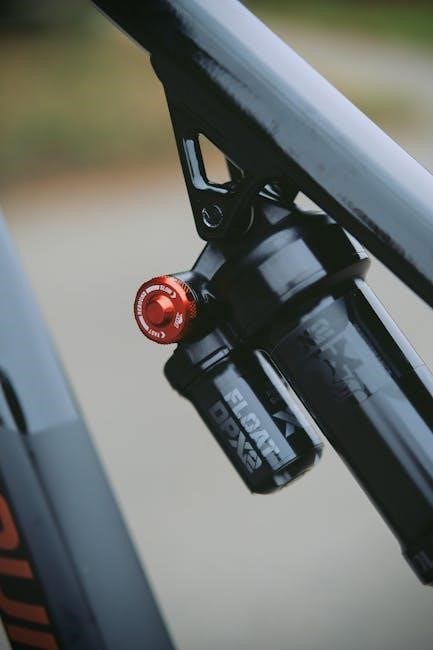Choosing the right mountain bike frame size is crucial for comfort, efficiency, and performance. This guide helps riders understand key measurements, body fit, and geometry to ensure optimal riding experience.
Why Frame Size Matters for Mountain Bikes
A properly fitted mountain bike frame is essential for optimal performance, comfort, and safety. A frame that is too large or too small can lead to poor handling, reduced efficiency, and discomfort during long rides. The right frame size ensures better control, especially on technical terrain, and maximizes pedaling efficiency. It also helps maintain proper posture, reducing the risk of fatigue and injury. By matching the bike’s geometry to the rider’s body, cyclists can enjoy a more enjoyable and effective riding experience. A well-fitted frame is crucial for balancing speed, agility, and stability, making it a cornerstone of a great mountain biking experience.
Key Factors to Consider for a Comfortable and Efficient Ride
When selecting a mountain bike frame, several factors contribute to a comfortable and efficient ride. Body measurements, such as inseam, torso, and arm length, play a significant role in determining the ideal fit. Bike geometry, including reach, stack, and standover height, must align with the rider’s proportions and riding style. Additionally, the type of mountain biking—whether cross-country, trail, or downhill—affects frame size and design. Personal fit preferences, such as handlebar height and saddle position, also influence comfort. Ensuring proper alignment and balance between the rider and bike is crucial for optimal performance and enjoyment on the trails.
Understanding Mountain Bike Frame Size Measurements
Mountain bike frame size measurements focus on key dimensions like reach, stack, standover height, and wheelbase. These metrics ensure proper fit, stability, and optimal performance for riders.
How Frame Size is Measured and What It Means for Riders
Frame size is typically measured by the horizontal distance between the bottom bracket and the head tube, known as the reach. This measurement, along with stack (vertical height) and standover height, determines the bike’s fit. Proper frame size ensures optimal ergonomics, comfort, and control. A well-fitted frame allows riders to maintain an efficient pedaling position while handling the bike confidently. Incorrect sizing can lead to discomfort, fatigue, or difficulty in maneuvering. Understanding these measurements helps riders select a frame that aligns with their body proportions and riding style, enhancing overall performance and enjoyment on the trails.
Numerical vs. Alphabetical Sizing: What’s the Difference?
Mountain bike frames are sized using numerical or alphabetical systems. Numerical sizing, measured in inches, reflects the bike’s seat tube length, while alphabetical sizing (e.g., XS, S, M) is relative to rider height and inseam. Numerical sizing is more precise, offering consistent sizing across brands, while alphabetical sizing provides a broader fit range. Riders should consider their riding style and body proportions when choosing between systems. Both methods aim to ensure proper fit, but numerical sizing is often preferred for its accuracy, while alphabetical sizing offers flexibility for varying body types and preferences.
Body Measurements for Choosing the Right Frame Size
Accurate body measurements, such as inseam, torso, and arm length, are essential for selecting the correct mountain bike frame size, ensuring a proper fit and optimal performance.
The Importance of Inseam for Mountain Bike Sizing
Inseam is a critical measurement for determining the ideal mountain bike frame size, as it directly impacts standover clearance and riding comfort. To measure inseam, stand against a wall with feet flat, wearing cycling shoes, and measure the distance from the floor to the crotch. This ensures proper clearance when straddling the bike. A correct inseam-to-frame-size ratio prevents discomfort and improves posture. Additionally, inseam helps estimate saddle height for optimal pedaling efficiency. Accurate inseam measurement is essential for a safe and efficient ride, making it a cornerstone of the bike sizing process.
How to Measure Torso and Arm Length for a Perfect Fit
Measuring torso and arm length is essential for ensuring proper fit and comfort on a mountain bike. To measure torso length, stand straight against a wall and measure from the base of the neck to the hipbone. For arm length, extend your arm to the side at shoulder height and measure from the center of the shoulder to the wrist. These measurements help determine handlebar reach and overall bike geometry; Proper torso and arm alignment ensure optimal control and comfort, reducing strain on the back and shoulders. Accurate measurements also guide component choices, like stem length and handlebar width, for a personalized fit.
Mountain Bike Geometry and Its Impact on Frame Size
Mountain bike geometry, including reach, stack, and wheelbase, directly influences frame size and ride quality. These measurements determine handling, stability, and rider comfort, ensuring optimal performance.
Reach, Stack, and Wheelbase: Key Geometry Measurements
Reach, stack, and wheelbase are critical geometry measurements that influence a mountain bike’s handling and rider comfort. Reach is the horizontal distance between the bottom bracket and head tube, affecting how stretched or compact the riding position feels. Stack measures the vertical distance from the bottom bracket to the top of the head tube, impacting standover height and saddle-to-handlebar drop. Wheelbase, the distance between the front and rear axles, determines stability and maneuverability. Together, these measurements shape the bike’s overall geometry, ensuring optimal performance for various riding styles and terrain, from tight trails to high-speed descents.
Standover Height: What It Is and Why It Matters
Standover height measures the distance between the ground and the top tube of the bike frame. It ensures a rider can safely straddle the bike with both feet flat on the ground, providing clearance and control. Proper standover height is essential for comfort, safety, and maneuverability. Too little clearance can lead to discomfort or difficulty dismounting, while excessive clearance may affect handling. It’s measured while wearing cycling shoes and is a key factor in ensuring the bike fits the rider’s body proportions. Correct standover height ensures optimal body positioning and bike control, making it a critical measurement for a safe and enjoyable riding experience.
How to Test and Ensure the Best Fit
Test rides are essential to confirm comfort and performance. Check standover clearance, seat height, and handlebar reach to ensure proper fit and optimal riding experience.
Physical Evaluation: How to Check Standover Clearance
Standover clearance is a critical factor in ensuring a proper bike fit. To check it, stand over the bike with your feet flat on the floor, wearing your cycling shoes. Measure the clearance between the bike’s top tube and your inseam. A minimum of 1-2 inches (2.5-5 cm) is recommended for XC bikes, while larger bikes, like enduro or downhill, may require slightly more clearance. This clearance ensures you can safely dismount and maneuver the bike without discomfort or injury. Proper standover clearance is essential for both safety and optimal riding performance.
Test Rides: The Final Step in Confirming the Right Size
Test rides are the ultimate way to confirm if a mountain bike frame size is right for you. After narrowing down your options using size charts and measurements, a test ride provides real-world feedback on comfort, handling, and efficiency. Pay attention to how the bike feels during climbs, descents, and technical sections. Ensure you can maintain control, reach the controls comfortably, and maneuver the bike effortlessly. A proper fit enhances performance and reduces fatigue. Take your time during the test ride, as it’s the final step in ensuring the bike aligns with your body and riding style for an optimal experience.

Mountain Bike Frame Size Charts and Guides
Mountain bike frame size charts provide standardized measurements based on rider height, inseam, and torso length, helping riders select the optimal frame size for their body.
Using Size Charts for Different Types of Mountain Bikes
Size charts vary across mountain bike types, such as cross-country, trail, enduro, and downhill bikes, due to differences in geometry and intended use. Riders should consult charts specific to their bike type to ensure proper fit. Key measurements include height, inseam, and torso length, which correlate to frame sizes. These charts provide a starting point, but personal preferences and riding style may require adjustments. Always test ride a bike to confirm fit, as sizing can vary slightly between brands and models. Proper fit ensures comfort, control, and optimal performance on the trails.

Customizing Your Mountain Bike for a Better Fit
Customizing your mountain bike involves adjusting components like stems, handlebars, and saddles to optimize comfort and performance. Tailor your bike to fit your body and riding style perfectly.
Adjustments and Components to Optimize Your Ride
Customizing your mountain bike involves more than just frame size. Adjusting components like stems, handlebars, and saddles can significantly enhance comfort and performance. A shorter stem can improve maneuverability, while a wider handlebar boosts control. Saddle height and angle should be tailored to your body to avoid discomfort and maximize pedaling efficiency. Additionally, crank arm length and gear ratios can be fine-tuned to suit your riding style and terrain. Even small tweaks, like grip size or pedal preference, can make a big difference. By optimizing these elements, you can create a bike that feels like an extension of your body, ensuring a more enjoyable and efficient ride.

Common Mistakes to Avoid When Choosing a Frame Size
After selecting the right frame size, fine-tuning your mountain bike with proper adjustments and components can significantly enhance your riding experience. A correctly fitted stem and handlebars ensure optimal reach and control, while a well-adjusted saddle height and angle prevent discomfort and improve pedaling efficiency. Crank arm length and pedal choice should match your leg length and riding style, and tire pressure adjustments can optimize traction and handling. Customizing components like grips, brake levers, and gear ratios allows for a personalized fit, ensuring your bike performs as an extension of your body for maximum comfort and performance on the trails.
Choosing the right mountain bike frame size is essential for comfort, efficiency, and performance. Always test ride, consult experts, and adjust components for the best fit and riding experience.
Proper frame size ensures comfort, efficiency, and control. Measure inseam, torso, and arm length to determine the ideal fit. Consider bike geometry, including reach, stack, and standover height. Test ride bikes to confirm comfort and handling. Adjust components like stem and saddle height for optimal ergonomics. Use size charts as a guide but prioritize personal fit and riding style. Avoid common mistakes like prioritizing style over fit. Consulting experts or using online tools can further refine your selection for the best mountain biking experience.

Additional Resources for Further Reading
Explore expert guides, tools, and articles from reputable sources like BikeRadar and REI for in-depth frame size calculations and personalized fit recommendations to enhance your mountain biking experience;
Recommended Guides, Tools, and Expert Advice
For precise mountain bike sizing, utilize expert guides like BikeRadar’s Ultimate Guide to Mountain Bike Sizes and REI’s Bike Size and Fit article. Tools such as bike size calculators and apps like BikeRadar’s Mountain Bike Size Calculator offer personalized recommendations. Consulting with professional bike fitters or local shops ensures tailored advice. Additional resources include YouTube tutorials from trusted channels like Global Mountain Bike Network and Pinkbike, which provide visual guides and tips. These resources help riders understand complex sizing metrics and geometry, ensuring a perfect fit for optimal performance and comfort on the trails.



